This is a project we did over the summer and kept meaning to Instagram, but it refused to be contained by the limits of one shot just like the writers of The Walking Dead refuse to care about our VERY REAL FEELINGS about very fictional characters. But I digress. So here we are, swinging by like we mentioned we might randomly do in our update post/podcast.
We had filed this idea away for waaaay down the line (thinking it would be cost and time intensive), but turns out it was actually neither. In fact, as the sun set on the very same day that we started, we got to enjoy the finished product.
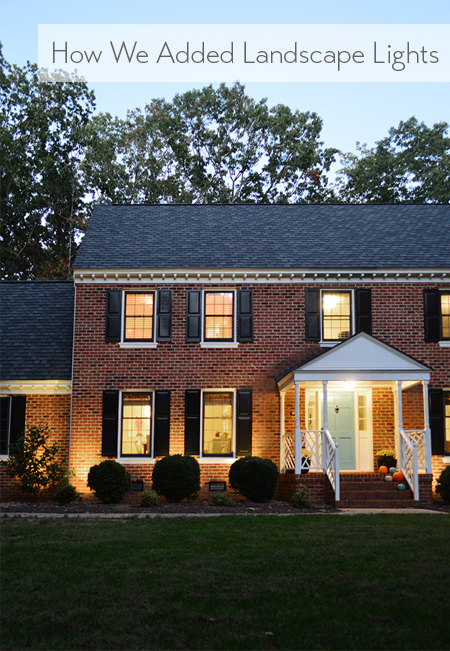
We’ve always gawked lustily at the homes in our neighborhood with landscape lighting (so stately!). You know, that welcoming come-hither glfow in the evening hours. And when we saw Sarah at Thrifty Decor Chick post this tutorial, it quickly leapt to the top of our to-do list. I’ll fess up that we didn’t photograph the installation process very thoroughly (read: at all), but the whole connecting wires part was pretty straight-forward.
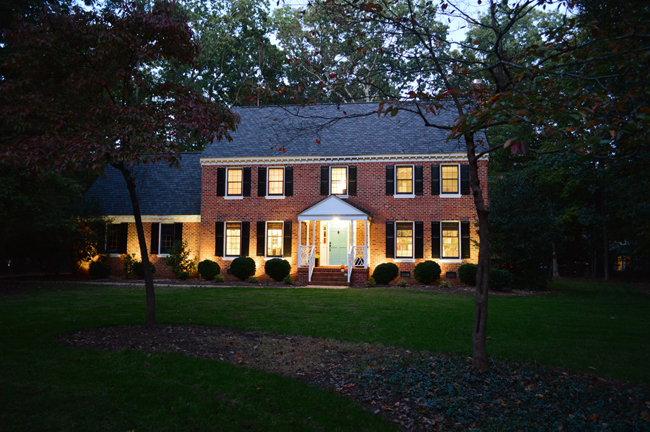
It was the planning and buying of materials that made our heads spin just a little – mostly because there was a smattering of math and some proper material selections that had to happen.
Based on the ingredients of this a lighting kit that Sarah mentioned, we knew we needed three basic elements: lights + a power pack + cable. It was getting the right combination of these that put the ol’ noggin to work.
Note: The products we used are no longer available, but this kit is similar but more affordable (plus, the lights are LED, not halogen like ours).
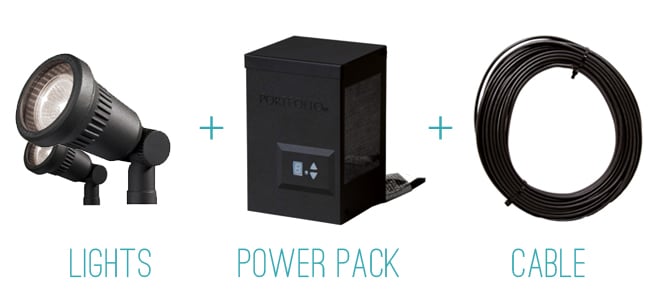
The lights were the easy part, since we stuck with the same 20W halogen spotlights that came in that kit. And it also didn’t take much research (scoping houses online and around our ‘hood) to determine that we wanted one between each downstairs window and on the house’s front corners, so we bought enough to fill those spots.
The power pack is where it started to get math-y. Also called a transformer, its job is to convert your outlet’s 120V electricity to the 12V low-voltage that these lighting systems run on. But it’s up to you to make sure you have one with enough power to illuminate all of your lights. So you add up the total wattage of all of your fixtures (in our case, 20 Watts X 9 lights = 180 Watts) and then choose a power pack with enough wattage, plus a little extra (at Lowe’s they suggest at least 20W extra). We chose a 200 watt transformer, which just plugs into any exterior outlet, and made sure it was a “multi-tap” version (meaning we could connect or “tap in” more than one wire). Which leads us to another thing we learned along the way…
The cable also requires some forethought. You typically want to keep your cable as short as possible (voltage drops the farther you get from your power source) and you risk your last light looking dimmer than your first one if you connect too many lights on any one long length of cable. So there are all sorts of strategies and charts for wiring your lights for the most even placement of lights along your wires (there are also other charts like this one to help tell you what size/gauge wire you should be buying). We split our lights onto two separate sections of similar-length 14-gauge cable, each running to either side of the front porch based on some of those recommendations.
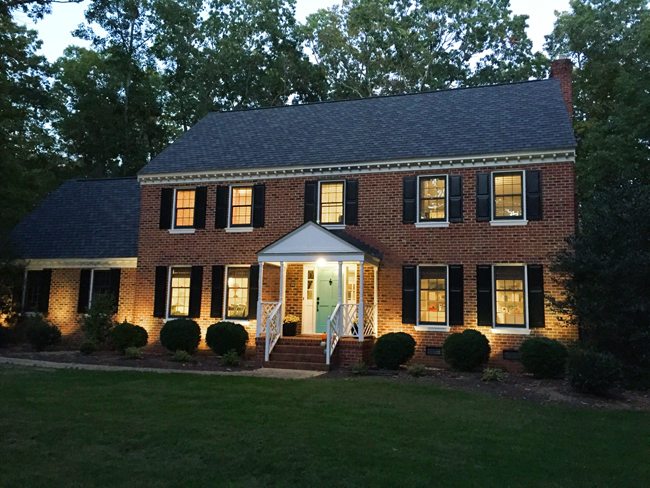
Again, once we knew where everything was going, the actual wire-connecting, light-placement, and wire-burying was a cinch. You do all the wire connecting before the transformer is plugged in (three cheers for no live wires to worry about while you work!) so first we staked our spotlights into the ground and loosely laid our cable along them. Then we just connected each light to the main cable by screwing the light’s connector cap tightly over the cable according to the installation instructions – no tools needed. Below is a connection we unearthed this weekend so you can sorta see what it looks like.
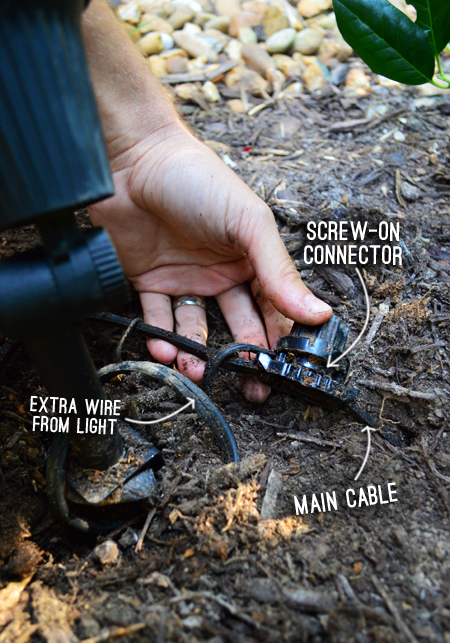
Since we used two cables instead of one long one that loops back to the transformer box, we did have to figure out what to do with the outside ends of each cable. After some research we went with waterproof wire caps which are made to withstand moisture and corrosion (we hear they’re great for buried applications like this).
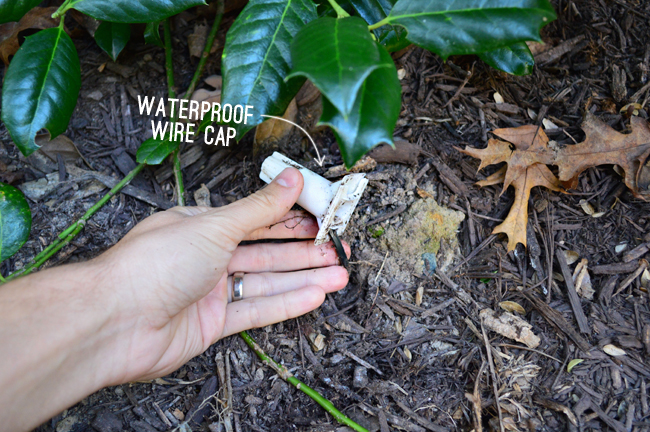
Then it was time to connect the cables to the underside of the transformer, which did call for some basic wire clippers to expose the end of the wires. Once we did that, we could plug the transformer into the outlet on our front porch, and mount it to the brick to keep it a few inches off the ground (both for looks and in case of any post-rain porch puddles). We nudged the planter to the side for this photo, but it normally hides the box and outlet from view.
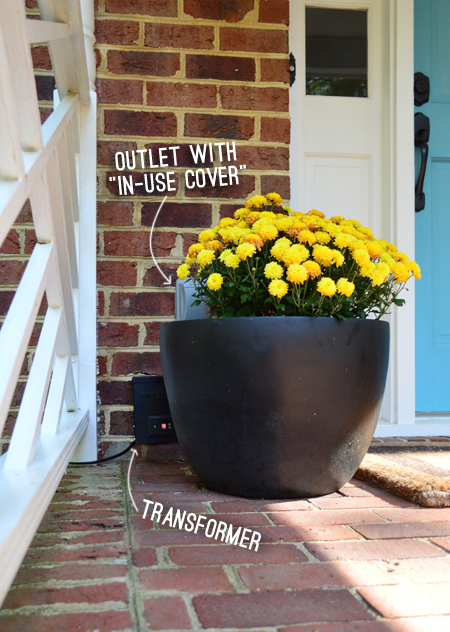
Once we had connected everything and plugged in the transformer, we used the darker evening light to fine tune everything (like tweaking the angle of the spotlights and the placement of the stakes) to make sure we liked how the light was hitting the house. There’s about a foot of cord between the light and where it attaches to the cable, so even after everything’s connected you’ve got some wiggle room to move lights around a bit if needed.
After we were done tweaking our placement at night, all we had to do was dig everything in when we had some daylight the next morning. So we dug a small trench a few inches below ground level and buried all of the exposed cables, connectors, and wire caps. Since they’re all contained within the bounds of our mulch bed, it’s nice that we don’t have to worry about cutting anything with an aerator or some other lawn tool.
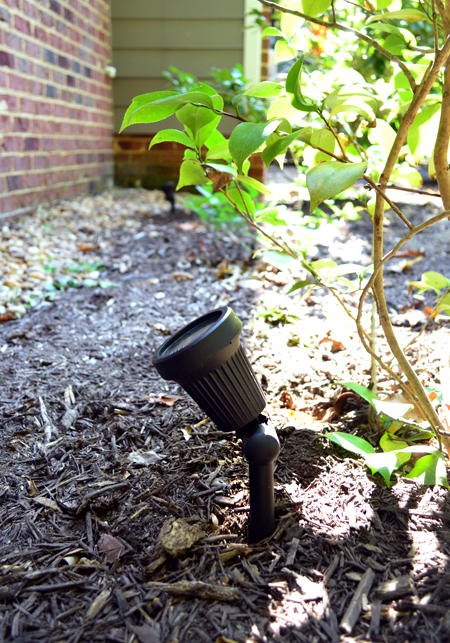
As you can see in the time-lapse video below, they automatically turn on when it gets dark thanks to a light sensor on the power pack. It also has a digital timer where you can set how many hours they stay on (ours go off around the time we hit the hay). We love that they’re so auto-pilot and in total I think they cost us a little over $200 and took about four hours to install.
Oh, and check out the set-up we used to capture the video above. Why yes, that’s a selfie stick clamped to an old stepladder (we used the iPhone’s time lapse feature and then went inside for dinner while it did its thing). I’m sure the neighbors were scratching their heads over that one.
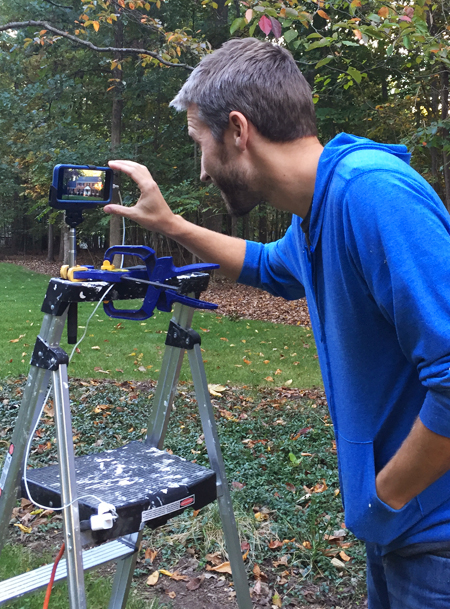
We’re happy to report that these lights have been going strong for quite a few months and we still get excited whenever we roll down the street at night and they’ve already clicked on, ready to welcome us home.
UPDATE! We have since transitioned our entire house to LED lights (they save tons of energy & money, and they’re a lazy person’s best friend because you never have to change them). For anyone wondering, these are our favorite interior LEDs (their glow is warm & natural – not weird/blue like some of the others we’ve tried) and these are the exterior ones that we now use for our uplighting (they come in a pack of 4).
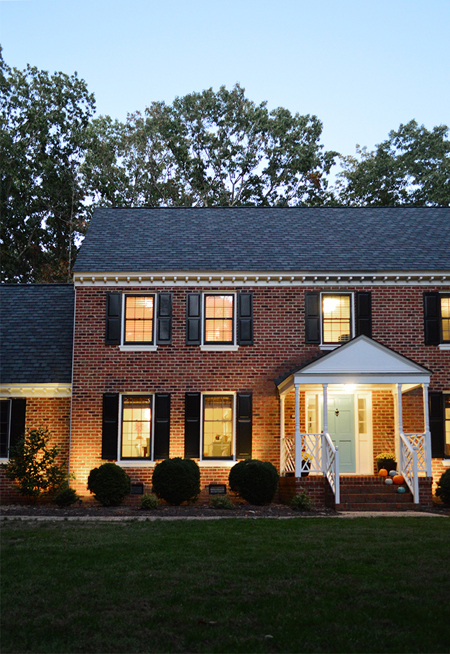
UPDATE #2! Since moving to our new house, we’ve found a way to illuminate our backyard using *only* solar lights. Check out the post we wrote for our favorite outdoor solar lights.
Psst – We finally created this Shop Our House page to help you hunt down any furniture/accessories that you see in our house, along with all of our paint colors.
* This page contains affiliate links
